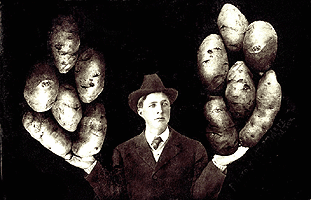|
There is a lot to be said for the potato: satisfying, filling, nutritious, historic (think Irish Potato Famine.) The spud even has a secret artistic side: in its lowliest form, pulverized into a powder of starch, it is the key ingredient of the most beautiful color photographs ever made.
Called “Autochromes,” these potato-powered pictures on glass were the earliest natural-color photographs to achieve success in the marketplace. The process for making the plates was patented by the French brothers Louis and Auguste Lumiere of Lyon, just a few short years after their invention of the cinema. Although the French patent for Autochrome plates was issued in 1904, it wasn’t until three years later that manufacturing problems were solved and the plates went on sale.
On June 10, 1907, the Lumiere brothers unveiled their process at the Photo Club de Paris. Alfred Stieglitz and Edward Steichen, the leading lights of the American art-photography movement called the Photo-Secession, happened to be in Paris at the time. Steichen attended the Photo Club event and immediately began making Autochromes, but it was Stieglitz who spread the word. He wrote to the London journal Photography,
|
The possibilities of the process seem to be unlimited… It is a positive pleasure to watch the faces of the doubting Thomases– the painters and the art critics especially — as they listen interestedly about what the process can do. You feel their cynical smile. Then, showing them the transparencies, one and all faces look positively paralysed, stunned… then enthusiasm, delighted, unbounded, breaks loose…
All are amazed at the remarkably truthful color rendering; the wonderful luminosity of the shadows, that bug-bear of the photographer in monochrome; the endless range of grays, the richness of the deep colors. In short, soon the world will be color-mad, and Lumiere will be responsible.
|
The inventive Lumieres had found a way to apply a principle of color reproduction first demonstrated in 1861: all of the colors of nature can be captured and reconstructed using three primary colors of light — red, green, and blue. Most experimenters sought to take three simultaneous pictures of a scene, one through a red filter, one through a blue filter, and the third through a green filter. The three photographs were then combined into one by a projection system or a special viewer.
The Autochrome process instead used millions of tiny color filters spread over the surface of a single plate of glass. These microscopic specks were made of potato starch, dyed red-orange, green, and violet-blue. The Lumieres reported they used eight or nine thousand of these filters per square millimeter, which works out to between five and six million per square inch.
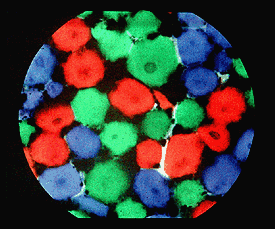 |
The potato starch grains are too small to be seen by the naked eye, but it proved impossible to mix them in a perfectly random pattern. The result was tiny clumps of same-color specks that could just barely be discerned. If you look at the background pattern of this text you’ll see the dot pattern from the light-blue sky of an Autochrome. Stand far enough away and you’ll see only a solid color, but get close and you can see the dots. Television screens and printed color photographs in a book or magazine work in much the same way, combining small spots of primary colors into a full range of color effects.
|
|
To make an Autochrome plate at their factory, the Lumieres began with a clear sheet of glass, which was coated with a thin, transparent layer of sticky varnish. The microscopic dots of dyed potato starch, blended into a fine grey powder, were then carefully dusted onto the sticky layer. This was precision work for the time, because it was important to have only one layer of dots. Next, the dots were squashed and flattened by running the glass plate through rollers exerting tremendous pressure– more than five tons per square inch.
After that, extremely fine black dust was used to fill up any spaces remaining between the flattened dots. The layer of colored specks was then sealed, and a light-sensitive black-and-white photographic emulsion was added. The plates were packed in light-tight boxes that could only be opened in a darkroom.
|
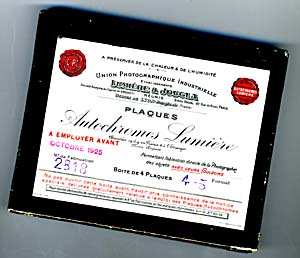
|
To understand how Autochrome plates work, it helps if you think of the black-and-white emulsion that’s behind each of the color dots. After exposure in the camera and processing, that light-sensitive layer becomes a positive transparency. Every place where light struck the emulsion during exposure becomes a clear spot, and every place where no light came through is opaque black.
When making an Autochrome of a red apple, for example, the red light from the exposure passes through the orange-red dots but is stopped by the green dots and the purple-blue dots. So every place there is a red dot the emulsion behind it ends up clear, while it’s black behind the green and violet-blue dots. When you hold the finished plate up to a light source, light passes through the clear spots and the red dots in front of them, and you see a patch of red light. But light is blocked by the black emulsion layer behind the green and violet-blue dots. All you see is the red of the apple.
|
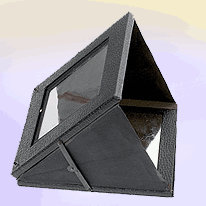
|
Special viewers called “Diascopes” were designed to heighten the experience of viewing these luminous color images. In a Diascope, the Autochrome image is seen reflected in a mirror, with all extraneous light blacked out.
|
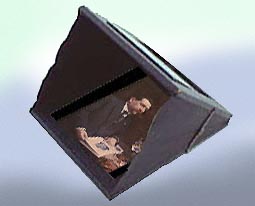
|
|
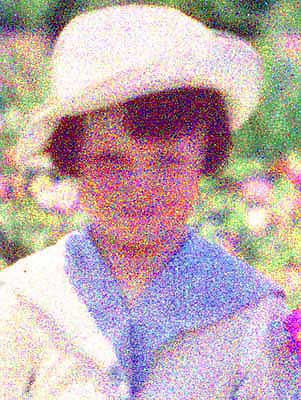
|
The experience of looking at an Autochrome has been likened to seeing a large stained-glass window from a distance; the picture is a glowing mosaic of colored light.
Because the color dots are so small and so closely packed, the colors of adjacent dots seem to blend together, just like the pixels on a video screen. Light from neighboring red and green dots combines to produce yellow, and violet-blue and green dots combine to make turquoise. A nearly endless array of colors can be created by this method.
When viewed close-up or under magnification, the dots of the Autochrome image become more apparent. The effect is often compared to the pointillist works of the French painter Georges Seurat, whose most famous canvas is A Sunday on La Grande Jatte (1884).
To view this exhibition with a broadband connection, please click “First Image” below. To see the images in reduced format and without text, click “Gallery View.”
|
|
![]()


